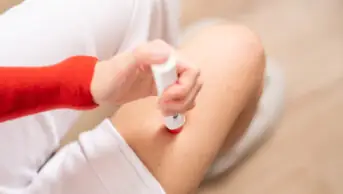Itching to experience Pharmacy First firsthand, I signed up to a locum community pharmacy Saturday shift in my area. I arrived at work slightly more animated than usual having already familiarised myself with the relevant self-assessment framework and patient group directions.
My first consultation was straightforward: a UTI. The second was anything but. Presenting was a Black nine-year-old boy, accompanied by his mother. He had what looked to be non-bullous impetigo, judging by a crust localised around the mouth, with some red marks. The crust was only mildly itchy, with no accompanying fever. He was on no other medication, had no active underlying skin conditions and no open wounds in the immediate vicinity of the crust.
So far, so straightforward.
However, up until that Saturday, I had only ever seen non-bullous impetigo on white skin. In those children, the crust had been a golden-brown colour. But on the child in front of me, the crust was lighter — more yellow — and this gave me pause for thought. Was this really the same condition? I had explained my thoughts to the mother and child throughout the consultation process, and now I explained my doubt. I asked them if I could consult my phone, because I had just remembered seeing a photograph of impetigo on black skin in the Centre for Postgraduate Pharmacy Education’s (CPPE) dermatology e-learning.
I located the photo and it immediately erased my doubt. The crust in the image was clearly a lighter yellow than would typically be seen on white skin, but it was definitely impetigo. The mother agreed, and even told me how glad she was to have been so involved in the consultation, which she said had left her with a better understanding of the condition. Moreover, the son was seemingly thrilled to have seen a photo of a boy with the same skin condition. As he pointed at the phone and exclaimed “that’s what I have”, the mother reflected that this was the first time she had seen a photographic example of a Black child in a healthcare setting.
As I walked home that evening, I reflected on how much I had enjoyed my first experience of Pharmacy First. It is important not to draw too many conclusions from one encounter, but the gratitude from both mother and son felt so genuine that it left me wanting to do more shifts. I felt prompted to consider further: what other skin conditions present differently on black skin, and what can I do to help increase the diversity of images in healthcare settings?
In my privileged position as clinical fellow at CPPE, I can continue to advocate for diverse images to be used in their education materials, as well as lobby undergraduate pharmacy institutions to do the same. However, something that I must start to do is to contribute directly to projects such as Black & Brown Skin or DermNet, where healthcare professionals can submit their own clinical photos with patient’s consent to help improve access to resources.
This is something that we as healthcare professionals can all do, regardless of profession or seniority. I was glad I could help the mother and child who came into my pharmacy, but let’s make sure that their first time seeing a photographic example of a Black child in a healthcare setting is not also their last.
Shy Teli, chief pharmaceutical officer’s clinical fellow, Centre for Postgraduate Pharmacy Education
2 comments
You must be logged in to post a comment.



Thank you Shy for your letter and experience that really does highlight why it is important to include diverse clinical imagery within health education.
The notable lack of representation of conditions that affect skin of colour, as well as minimal expansion of statistics about conditions that predominantly affect Black people, is something that The PJ first highlighted in November 2021 in this episode of the PJPod (https://pharmaceutical-journal.com/article/feature/pale-and-stale-decolonising-the-pharmacy-degree). It specifically looked how then pharmacy student Adanna Anthony-Okeke led a project to ‘decolonise’ the curriculum at the University of Nottingham’s school of pharmacy and investigated the progress being made in universities across the UK to make the pharmacy degree more inclusive.
Subsequent to this, The PJ also produced specific learning materials with visual guides that sought to help pharmacists and pharmacy teams better recognise common skin conditions in people of colour, including eczema, psoriasis, acne vulgaris and fungal skin infections, see: https://pharmaceutical-journal.com/article/ld/recognising-common-skin-conditions-in-people-of-colour. More specifically, those skin conditions more commonly observed in skin of colour, such as melasma, post-inflammatory hyperpigmentation, traction alopecia, central centrifugal cicatricial alopecia and tinea capitis, see: https://pharmaceutical-journal.com/article/ld/common-dermatological-conditions-in-skin-of-colour.
Our approach to inclusion of clinical images in our content is to be as inclusive as possible. We rely on various image banks and, as you note, projects such as Black & Brown Skin or DermNet, as well as our expert clinical authors, to help with this. We support your call for more healthcare professionals to submit their own clinical photos, of course with appropriate patient consent, to help improve access to inclusive resources.
Thank you again for sharing your experience and for bringing this to attention.
Readers looking for PJ resources to support delivery of Pharmacy First and similar services across GB can access learning content by country or condition via our minor ailments hub here: https://pharmaceutical-journal.com/minor-ailments.
Michael Dowdall – Executive Editor, Research & Learning
I can highly recommend the book Mind The Gap (https://www.blackandbrownskin.co.uk/mindthegap) to help increase awareness of dermatological signs and symptoms in people of colour.